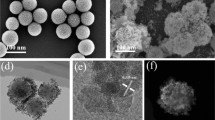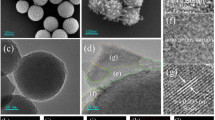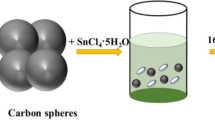Abstract
Tin oxide is one of the most promising anode materials for lithium-ion batteries (LIBs) due to its high capacity and easy availability. However, its application is often hampered by the severe volume expansion during lithiation and delithiation process, causing a lower capacity retention rate. In this work, C@SnO2 core–shell nanostructure was constructed by using one-step hydrothermal method. In this nano-architecture, SnO2 nanoparticles are trapped and supported by carbon via the interfacial coupling effect. Benefiting from the structure and compositional characteristics, C@SnO2 electrodes display excellent lithium storage performance, when used as anode material for lithium-ion battery. It delivers a high initial discharge capacity of 1420 mA h g−1 and maintains a discharge capacity of 541 mA h g−1 after 150 cycles at the current density of 100 mA g−1, which is superior to the SnO2 and carbon electrodes. The enhanced electrochemical performance can be attributed to the construction of core–shell structure; the C@SnO2 has numerous void spaces and good electrical conductivity. It can effectively prevent the aggregation of SnO2 nanoparticles and shorten the diffusion path during electrochemical cycles, leading to the excellent lithium storage performance. This work provides a simple strategy to construct improved transition metal oxide electrodes for energy storage.





Similar content being viewed by others
References
Dong Y, Liu S, Liu Y, Tang Y, Yang T, Wang X, Wang Z, Zhao Z, Qiu J (2016) Rational design of metal oxide hollow nanostructures decorated carbon nanosheets for superior lithium storage. J Mater Chem A 4:17718–17725
Deng L, Chen JZXJ, Ding M, Liu H (2018) Three-dimensional elastic ultrathin reduced graphene oxide coating SnS2 hierarchical microsphere as lithium ion batteries anode materials. J. Alloy. Compd. 739(1015):1024
Chu Y, Guo L, Xi B, Feng Z, Wu F, Lin Y, Xiong S (2017) Embedding MnO@Mn3O4 nanoparticles in an N-doped carbon framework derived from Mn-organic clusters for Efficient lithium storage. Adv Mater 30:1704244
Li R, Miao C, Yu L, Zhang M, Xiao W (2020) Novel self-assembled SnO2@SnS2 hybrid microspheres as potential anode materials for lithium-ion batteries. Mater. Lett. 272:127851
Jiang X, Yang X, Zhu Y, Shen J, Fan K, Li C (2013) In situ assembly of graphene sheets-supported SnS2 nanoplates into 3D macroporous aerogels for high-performance lithium ion batteries. J Power Sources 237:178–186
Hu CL, Shu H, Shen Z, Zhao T, Liang P, Chen X (2018) Hierarchical MoO3/SnS2 core-shell nanowires with enhanced electrochemical performance for lithium-ion batteries. Phys Chem Chem Phys 20:17171–17179
Suo G, Li D, Feng L, Hou X, Ye X, Zhang L, Yu Q, Yang Y, Wang W (2019) Construction of SnS2/SnO2 heterostructures with enhanced potassium storage performance. J Mater Sci Technol 55:167–172
Chen K, Wang X, Wang G, Wang B, Liu X, Bai J, Wang H (2018) A new generation of high performance anode materials with semiconductor heterojunction structure of SnSe/SnO2@Gr in lithium-ion batteries. Chem Eng J 347:552–562
Asen P, Haghighi M, Shahrokhian S, Taghavinia N (2019) One step synthesis of SnS2-SnO2 nano-heterostructured as an electrode material for supercapacitor applications. J Alloy Compd 782:38–50
Abdel Hamid AA, Yu Y, Yang J, Ying JY (2017) Generalized synthesis of metal oxide nanosheets and their application as Li-Ion battery anodes. Adv Mater 29:1701427
Yang X, Xiao F, Wang S, Liu J, Leung MKH, Yu DYW, Rogach AL (2019) Confined annealing-induced transformation of tin oxide into sulfide for sodium storage applications. J Mater Chem A 7:11877–11885
Zhu S, Li J, Deng X, He C, Liu E, He F, Shi C, Zhao N (2017) Ultrathin-nanosheet-induced synthesis of 3D transition metal oxides networks for lithium ion battery anodes. Adv Funct Mater 27:1605017
Wang M, Lei M, Wang Z, Zhao X, Xu J, Yang W, Huang Y, Li X (2016) Scalable preparation of porous micron-SnO2/C composites as high performance anode material for lithium ion battery. J Power Sources 309:238–244
Yin L, Chai S, Huang J, Kong X, Pan L (2017) Preparation of hierarchical SnS2 /SnO2 anode with enhanced electrochemical performances for lithium-ion battery. Electrochim Acta 238:168–177
Zhu Y, Cao T, Li Z, Chen C, Peng Q, Wang D, Li Y (2018) Two-dimensional SnO2/graphene heterostructures for highly reversible electrochemical lithium storage. Sci China-Mater 61:1527–1535
Yao X, Ke Y, Ren W, Wang X, Xiong F, Yang W, Qin M, Li Q, Mai L (2018) Defect-rich soft carbon porous nanosheets for fast and high-capacity sodium-ion storage. Adv Energy Mater 9:1803260
Yang T, Liang J, Sultana I, Rahman MM, Monteiro MJ, Chen Y, Shao Z, Silva SRP, Liu J (2018) Formation of hollow MoS2/carbon microspheres for high capacity and high-rate reversible alkali-ion storage. J Mater Chem A 6:8280–8288
Pei F, An T, Zang J, Zhao X, Fang X, Zheng M, Dong Q, Zheng N (2016) From hollow carbon spheres to N-doped hollow porous carbon bowls: rational design of hollow carbon host for Li-S batteries. Adv Energy Mater 6:1502539
Hu R, Ouyang Y, Liang T, Tang X, Yuan B, Liu J, Zhang L, Yang L, Zhu M (2017) Inhibiting grain coarsening and inducing oxygen vacancies: the roles of Mn in achieving a highly reversible conversion reaction and a long life SnO2-Mn-graphite ternary anode. Energy Environ Sci 10:2017–2029
Zhan L, Zhou X, Luo J, Ning X (2019) Binder-free multilayered SnO2/graphene on Ni foam as a high-performance lithium ion batteries anode. Ceram Int 45:6931–6936
Wu J, Liu Y, Cui Y, Ouyang J, Baker AP, Li Z, Zhang H (2018) Pluronic F127 as auxiliary template for preparing nitrogen and oxygen dual doped mesoporous carbon cathode of lithium-oxygen batteries. J Phys Chem Solids 113:31–38
Gao C, Jiang Z, Wang P, Jensen LR, Zhang Y, Yue Y (2020) Optimized assembling of MOF/SnO2/graphene leads to superior anode for lithium ion batteries. Nano energy 74:104868
Wang J, Sun H, Rui ZR, Zhao X, Zhang H, Liu C. Wei (2018) three-dimensional microflowers assembled by carbon-encapsulated-SnS nanosheets for superior Li-ion storage performance. J. Alloy. Compd. 767(361):367
Tian Z, Zhao J, Li B, Feng Y, Song J, Niu C, Shao L, Zhang W (2020) Controllable synthesis of 3D porous SnO2/carbon towards enhanced lithium-ion batteries. Ionics 26:2773–2779
Li D, Sun Q, Zhang Y, Chen L, Wang Z, Liang Z, Si P, Ci L (2019) Surface-confined SnS2 @C@rGO as high-performance anode materials for sodium- and potassium-ion batteries. Chemsuschem 12:2689–2700
Xia Y, Han S, Zhu Y, Liang Y, Gu M (2019) Stable cycling of mesoporous Sn4P3/SnO2@C nanosphere anode with high initial coulombic efficiency for Li-ion batteries. Adv Energy Mater 18:125–132
Kim Y, Muhammad S, Kim H, Cho YH, Kim H, Kim JM, Yoon WS (2015) Probing the additional capacity and reaction mechanism of the RuO2 anode in lithium rechargeable batteries. Chemsuschem 8:2378–2384
Su W, Liang Y, Tang Y (2019) Facile situ synthesis of C@SnO2/Sn@rGO hybrid nanosheets as high performance anode materials for lithium-ion batteries. J Alloys Compd 801:402–408
Ming L, Zhang B, Zhang J, Wang X, Li H (2018) Chun-Hui Wang, SnO2@C/expanded graphite nanosheets as high performance anode materials for lithium ion batteries. J Alloys Compd 752:93–98
Wang X, Zhou X, Yao K, Zhang J, Liu Z (2011) A SnO2/graphene composite as a high stability electrode for lithium ion batteries. Carbon 49:133–139
Chen L, Wu P, Wang H, Ye Y, Xu B, Cao G, Zhou Y, Lu T, Yang Y (2014) Highly loaded SnO2/mesoporous carbon nanohybrid with well-improved lithium storage capability. J Power Sources 247:178–183
Lian P, Zhu X, Liang S, Li Z, Yang W, Wang H (2011) High reversible capacity of SnO2/graphene nanocomposite as an anode material for lithium-ion batteries. Electrochim Acta 56:4532–4539
Yao J, Shen X, Wang B, Liu H, Wang G (2009) In situ chemical synthesis of SnO2–graphene nanocomposite as anode materials for lithium-ion batteries. Electrochem Commun 11:1849–1852
Hu X, Zeng G, Chen JX, Lu CZ, Z.H. wen, (2017) 3D graphene network encapsulating SnO2 hollow spheres for high-performance anode material of lithium ion batteries. J. Mater. Chem. A 5(4535):4542
Huang S, Wang M, Jia P, Wang B, Zhang J, Zhao Y (2019) N-graphene motivated SnO2@SnS2 heterostructure quantum dots for high performance lithium/sodium storage. Energy Storage Mater 20:225–233
Cao B, Liu Z, Xu C, Huang J, Fang H, Chen Y (2019) High-rate-induced capacity evolution of mesoporous C@SnO2@C hollow nanospheres for ultra-long cycle lithium-ion batteries. J Power Sources 414:233–241
Liu X, Jiang Y, Li K, Xu F, Zhang P, Ding Y (2019) Electrospun free-standing N-doped C@SnO2 anode paper for flexible Li-ion batteries. Mater Res Bull 109:41–48
Liu X, Li K, Duan X, Huang Y, Li S, Liu Y, Xu F, Li Z, Zhang P, Ding Y (2018) Mechanical properties of individual core-shell-structured SnO2@C nanofibers investigated by atomic force microscopy and finite element method. Sci China-Technol Sci 61:1144–1149
Yin L, Song J, Yang J, Huang J, Li H, Bai P, Li S, Han L (2021) Construction of Ge/C nanospheres composite as highly efficient anode for lithium-ion batteries. J Mater Sci Mater Electron 32:6398–6407
Pan C, Zhang D, Shi L (2008) CTAB assisted hydrothermal synthesis, controlled conversion and CO oxidation properties of CeO2 nanoplates, nanotubes, and nanorods. J Solid State Chem 181:1298–1306
Lee K, Shin S, Degen T, Lee W, Yoon YS (2017) In situ analysis of SnO2 /Fe2O3 /RGO to unravel the structural collapse mechanism and enhanced electrical conductivity for lithium-ion batteries. Nano Energy 32:397–407
Funding
The study was financially supported by the National Natural Science Foundation of China (NSFC, Grant No. 51471124, U1766216), the National Key R&D Program of China (2018YFB0905600) and the Natural Science Foundation of Shaanxi Province, China (2019JM-189, 2020JM-218), and the Fundamental Research Funds for the Central Universities (CHD300102311405), HPC platform, Xi’an Jiaotong University.
Author information
Authors and Affiliations
Corresponding authors
Ethics declarations
Conflict of interest
The authors declare no competing interests.
Additional information
Publisher’s note
Springer Nature remains neutral with regard to jurisdictional claims in published maps and institutional affiliations.
Rights and permissions
About this article
Cite this article
Zhang, Y.K., Wang, H., Zhang, W.X. et al. Preparation of C@SnO2 core–shell nanostructure with enhanced electrochemical performance for lithium-ion batteries. Ionics 28, 181–189 (2022). https://doi.org/10.1007/s11581-021-04307-3
Received:
Revised:
Accepted:
Published:
Issue Date:
DOI: https://doi.org/10.1007/s11581-021-04307-3




